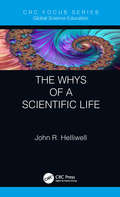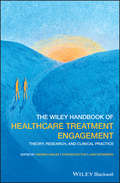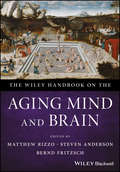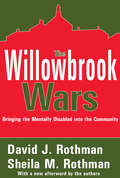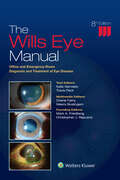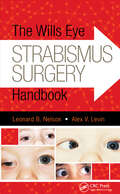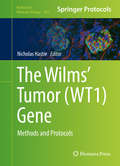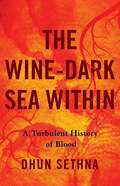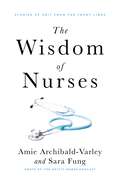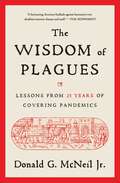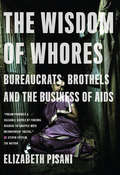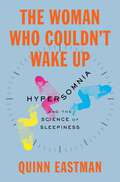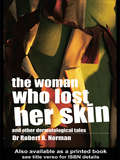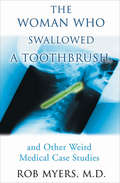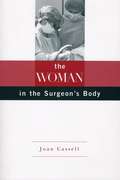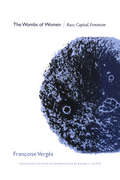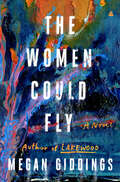- Table View
- List View
The Whys of a Scientific Life (Global Science Education)
by John R. HelliwellThe first in the Focus Series on Global Science Education, The Whys of a Scientific Life examines why scientists do what they do. Working from a diverse background in scientific research, including academic departments of physics and chemistry, as well as the scientific civil service, the author describes the choices scientists make. Fundamentally, a scientist asks questions based on curiosity. In addition, the environment is very important. By influencing their elected governments, society itself shapes the scientific research that is undertaken by scientists. This book follows on naturally from the author’s last book, Skills for a Scientific Life, which is a how-to guide for scientists and those that aspire to engage in science as a career. Key Features: User friendly and concise, this text dissects the whys of science and discovery The author has outstanding experience in mentoring science students and staff, and also in outreach activities for the public and students of all ages including schools The final chapter emphasises the joys of the scientist in research
The Wife He's Been Waiting For
by Dianne DrakeDr. Michael Sloan's brilliant surgical career ended after he was badly injured. Sheer strength and determination got him through, but scars run deep. Now, as a ship's doctor, he can avoid emotional entanglements. Until a beautiful passenger falls into his arms. . . . Dr. Sarah Collins has taken time out to travel the world and rebuild her shattered confidence. The attraction between her and the gorgeous doctor is instant. And as Michael shows Sarah she still has the ability to heal, Sarah makes Michael believe he is, most definitely, a man worth loving.
The Wild Mandrake: A Memoir
by Jason JobinOn the cusp of adulthood, a young writer’s life is stalled as he faces cancer that keeps coming back.Doctors used to tell him he was cured. That was a long time ago. Ever since he first left home at age nineteen, writer Jason Jobin has had cancer. Every five years, like clockwork, it relapses, and yet he always pulls through, surrounded by friends and family but isolated by illness. Chemotherapy, surgeries, radiation — these persist, but they aren’t the milestones of his life. They can’t be, he won’t let them be.From helicoptering into the Yukon backcountry to teaching in an elite writing program, Jason strives to enter adulthood with some normalcy, but his is the life of “a special case.” And he does live. He lives working at a deli for minimum wage as his students come down the hill to shop and ask what he’s doing there. He lives measuring out nausea pills and benzos while his roommates drink and smoke and party. He lives lying to girlfriends about past diagnoses because what can you say? What do you build on rubble? He lives high and low and in between. Again he is sick, again he is cured. It’s miraculous. A great gift. But never enough.Told in short glimpses, this story redefines what it means to survive. Jobin brings together the illuminated moments of loss and joy as he navigates chronic illness and builds from it something new and wildly unexpected.
The Wild and the Toxic: American Environmentalism and the Politics of Health
by Jennifer ThomsonHealth figures centrally in late twentieth-century environmental activism. There are many competing claims about the health of ecosystems, the health of the planet, and the health of humans, yet there is little agreement among the likes of D.C. lobbyists, grassroots organizers, eco-anarchist collectives, and science-based advocacy organizations about whose health matters most, or what health even means. In this book, Jennifer Thomson untangles the complex web of political, social, and intellectual developments that gave rise to the multiplicity of claims and concerns about environmental health. Thomson traces four strands of activism from the 1970s to the present: the environmental lobby, environmental justice groups, radical environmentalism and bioregionalism, and climate justice activism. By focusing on health, environmentalists were empowered to intervene in the rise of neoliberalism, the erosion of the regulatory state, and the decimation of mass-based progressive politics. Yet, as this book reveals, an individualist definition of health ultimately won out over more communal understandings. Considering this turn from collective solidarity toward individual health helps explain the near paralysis of collective action in the face of planetary disaster.
The Wiley Handbook of Healthcare Treatment Engagement: Theory, Research, and Clinical Practice
by Andrew Hadler Stephen Sutton Lars OsterbergAgainst a global backdrop of problematic adherence to medical treatment, this volume addresses and provides practical solutions to the simple question: “Why don’t patients take treatments that could save their lives?” The Wiley handbook of Healthcare Treatment Engagement offers a guide to the theory, research and clinical practice of promoting patient engagement in healthcare treatment at individual, organizational and systems levels. The concept of treatment engagement, as explained within the text, promotes a broader view than the related concept of treatment adherence. Treatment engagement encompasses more readily the lifestyle factors which may impact healthcare outcomes as much as medication-taking, as well as practical, economic and cultural factors which may determine access to treatment. Over a span of 32 chapters, an international panel of expert authors address this far-reaching and fascinating field, describing a broad range of evidence-based approaches which stand to improve clinical services and treatment outcomes, as well as the experience of users of healthcare service and practitioners alike. This comprehensive volume adopts an interdisciplinary approach to offer an understanding of the factors governing our healthcare systems and the motivations and behaviors of patients, clinicians and organizations. Presented in a user-friendly format for quick reference, the text first supports the reader’s understanding by exploring background topics such as the considerable impact of sub-optimal treatment adherence on healthcare outcomes, before describing practical clinical approaches to promote engagement in treatment, including chapters referring to specific patient populations. The text recognizes the support which may be required throughout the depth of each healthcare organization to promote patient engagement, and in the final section of the book, describes approaches to inform the development of healthcare services with which patients will be more likely to seek to engage. This important book: Provides a comprehensive summary of practical approaches developed across a wide range of clinical settings, integrating research findings and clinical literature from a variety of disciplines Introduces and compliments existing approaches to improve communication in healthcare settings and promote patient choice in planning treatment Presents a range of proven clinical solutions that will appeal to those seeking to improve outcomes on a budget Written for health professionals from all disciplines of clinical practice, as well as service planners and policy makers, The Wiley Handbook of Healthcare Treatment Engagement is a comprehensive guide for individual practitioners and organizations alike.
The Wiley Handbook on the Aging Mind and Brain
by Steven Anderson Bernd Fritzsch Matthew RizzoA thought-provoking treatise on understanding and treating the aging mind and brain This handbook recognizes the critical issues surrounding mind and brain health by tackling overarching and pragmatic needs so as to better understand these multifaceted issues. This includes summarizing and synthesizing critical evidence, approaches, and strategies from multidisciplinary research—all of which have advanced our understanding of the neural substrates of attention, perception, memory, language, decision-making, motor behavior, social cognition, emotion, and other mental functions. Written by a plethora of health experts from around the world, The Wiley Handbook on the Aging Mind and Brain offers in-depth contributions in 7 sections: Introduction; Methods of Assessment; Brain Functions and Behavior across the Lifespan; Cognition, Behavior and Disease; Optimizing Brain Function in Health and Disease; Forensics, Competence, Legal, Ethics and Policy Issues; and Conclusion and New Directions. Geared toward improving the recognition, diagnosis, and treatment of many brain-based disorders that occur in older adults and that cause disability and death Seeks to advance the care of patients who have perceptual, cognitive, language, memory, emotional, and many other behavioral symptoms associated with these disorders Addresses principles and practice relevant to challenges posed by the US National Academy of Sciences and National Institute of Aging (NIA) Presents materials at a scientific level that is appropriate for a wide variety of providers The Wiley Handbook on the Aging Mind and Brain is an important text for neurologists, psychiatrists, psychologists, physiatrists, geriatricians, nurses, pharmacists, social workers, and other primary caregivers who care for patients in routine and specialty practices as well as students, interns, residents, and fellows.
The Willowbrook Wars: Bringing the Mentally Disabled into the Community
by David J. RothmanThe Willowbrook Wars is a dramatic and illuminating account of the effort to close down a scandal-ridden institution and return its 5,400 handicapped residents to communities in New York. The wars began in 1972 with Geraldo Rivera's televised raid on the Willowbrook State School. They continued for three years in a federal courtroom, with civil libertarian lawyers persuading a conservative and conscience-stricken judge to expand the rights of the disabled, and they culminated in a 1975 consent decree, with the state of New York pledging to accomplish the unprecedented assignment in six years.From 1975 to 1982, David and Sheila Rothman observed this remarkable chapter in American reform of mental disabilities care. Would the state live up to its agreement without "dumping" residents into other nightmarish institutions? Would the lawyers prove as interested in meeting client needs as in securing client rights? Could a tradition-bound bureaucracy create a new network of community services? And finally, would a governor and a legislature tolerate such outside intervention, and if so, for how long? In answering these questions,The Willowbrook Wars takes us behind the scenes to clarify the role of the judiciary, the fate of the underprivileged, and the potential for social justice. In their new afterword, the authors bring the story up to date, describing the results of the closing of the institution in 1987 from the experiences of integrating the former residents into communities to the legal battles between the state of New York and advocates for the mentally handicapped.
The Wills Eye Manual: Office and Emergency Room Diagnosis and Treatment of Eye Disease
by Kalla Gervasio Travis PeckA best-selling source of compact, authoritative guidance on the treatment of ocular disorders in a variety of settings, The Wills Eye Manual, 8th Edition, is the comprehensive, high-yield reference of choice for both trainees and seasoned practitioners. It provides highly illustrated information on more than 200 ophthalmic conditions along with proven clinical recommendations from initial diagnosis through extended treatment. The consistent, bulleted outline format makes it ideal for portability and quick reference.
The Wills Eye Strabismus Surgery Handbook
by Leonard Nelson Alex LevinAlthough residents and pediatric ophthalmology fellows examine patients in the clinic, they may not be involved in surgery on the same patients and even less often get to follow the progress of these patients postoperatively. The Wills Eye Strabismus Surgery Handbook is designed to address this challenge in residency and fellowship education as a manual focused on developing surgical plans for strabismus patients. Drs. Leonard B. Nelson and Alex V. Levin and their contributors have organized The Wills Eye Strabismus Surgery Handbookto allow for the reader to take notes regarding their own diagnosis and treatment plan for each case that is presented. This workbook style and its practical, easy-to-read format make this resource useful for written and oral board preparation, and as a handy reference guide for use long after exams are over. Each chapter presents an introduction into the decision-making process for a specific strabismus condition, followed by the surgical plans selected by three expert Wills Eye Strabismus Center strabismologists with regard to their approach to the presented case. Summary remarks by the chapter editor briefly review the basic concepts in developing a diagnosis and treatment plan while bringing together the varied opinions offered by the strabismologists in order to put them in context.Topics covered include: Strabismus surgery decision making Esotropia Exotropia Dissociated vertical deviation Cranial nerve palsies Strabismus syndromes Strabismus in systemic disease Reoperations Nystagmus Other complex strabismus cases The Wills Eye Strabismus Surgery Handbook is an essential resource for residents and pediatric ophthalmology fellows, as well as other ophthalmologists, looking to develop their surgical planning skills. It is a helpful field guide for any ophthalmologists who does strabismus and who is looking for a handy addition to their reference shelf.
The Wilms' Tumor (WT1) Gene
by Nicholas HastieThis volume provides a thorough overview of the Wilms Tumour Gene (WT1). The book begins with three review chapters that cover the involvement of WT1 in pediatric cancer, kidney disease, and tissue development and homeostasis. The next few chapters discuss cell marking and lineage tracing, epicardial cell methodology, colony forming assays for bone marrow stem cells, angiogenesis assays and zebrafish tools. The next group of chapters explores the latest tools in genomics, molecular biology, and biochemistry. They discuss dissecting transcription factor function in cell free systems, ChiP seq, proteomics, RNA interactome, and multiphoton imaging of lipids, measuring the binding constants of protein-nucleic acid interactions, and bioinformatics approaches for analyzing Next Generation Sequence data. The final chapter discusses protocols for clinical trials for immune therapy using anti-WT1 peptides. Written in the highly successful "Methods in Molecular Biology" series format, chapters include introductions to their respective topics, lists of the necessary materials and reagents, step-by-step, readily reproducible laboratory protocols, and tips on troubleshooting and avoiding known pitfalls. Practical and thorough, "The Wilms Tumour (WT1) Gene: Methods and Protocols" is a valuable resource for anyone who is interested in the diverse methodologies used in WT1 research. "
The Wine-Dark Sea Within: A Turbulent History of Blood
by Dr. Dhun SethnaA revisionist history of medicine, in which blood plays the starring role Inspired by Homer&’s description of the ebb and flow of the &“wine dark sea,&” the ancient Greeks conceived a back-and-forth movement of blood. That false notion, perpetuated by the influential Roman physician Galen, prevailed for fifteen hundred years until William Harvey proved that blood circulates: the heart pumps blood in one direction through the arteries and it returns through the veins. Harvey&’s discovery revolutionized the life sciences by making possible an entirely new quantitative understanding of the cardiovascular system, a way of thinking on which many of our lifesaving medical interventions today depend. In The Wine-Dark Sea Within, cardiologist Dhun Sethna argues that Harvey&’s revelation inaugurated modern medicine and paved the way for groundbreaking advances from intravenous therapy, cardiac imaging, and stent insertions to bypass surgery, dialysis, and heart-lung machines. Weaving together three thousand years of global history, following bitter feuds and epic alliances, tragic failures and extraordinary advancements, this is a provocative history by a fresh voice in popular science.
The Winter Station
by Jody ShieldsAn aristocratic Russian doctor races to contain a deadly plague in an outpost city in Manchuria - before it spreads to the rest of the world. 1910: people are mysteriously dying at an alarming rate in the Russian-ruled city of Kharbin, a major railway outpost in Northern China. Strangely, some of the dead bodies vanish before they can be identified.During a dangerously cold winter in a city gripped by fear, the Baron, a wealthy Russian aristocrat and the city's medical commissioner, is determined to stop this mysterious plague. Battling local customs, an occupying army, and a brutal epidemic with no name, the Baron is torn between duty and compassion, between Western medical science and respect for Chinese tradition. His allies include a French doctor, a black marketeer, and a charismatic Chinese dwarf. His greatest refuge is the intimacy he shares with his young Chinese wife - but she has secrets of her own.Based on a true story that has been lost to history, set during the last days of imperial Russia, THE WINTER STATION is a richly textured and brilliant novel about mortality, fear and love.
The Wisdom of Nurses: Stories of Grit From the Front Lines
by Amie Archibald-Varley Sara FungFrom the hosts of the hit podcast The Gritty Nurse, stories of the challenges, heartbreak and humour of life on the front lineOne of the enduring lessons of the pandemic has been the pivotal role that nursing plays in health care—vital work that isn’t widely understood or, sadly, appreciated. Sara Fung and Amie Archibald-Varley started the wildly popular The Gritty Nurse podcast to give voice to nurses all over the world, including more than 400,000 nurses in Canada. The authors have quickly become sought-after speakers and advocates for nurses and are called on regularly by the media to talk about a wide range of issues around the profession. In their first book, they take you to the front line of nursing to show the compassion, selflessness and dedication of professionals who not only give it all for their patients, but get up and do it over and over again.
The Wisdom of Plagues: Lessons from 25 Years of Covering Pandemics
by Donald G. McNeil Jr.Award-winning New York Times reporter Donald G. McNeil, Jr. reflects on twenty-five years of covering pandemics—how governments react to them, how the media covers them, how they are exploited, and what we can do to prepare for the next one—in this &“fascinating, ferocious fusillade against humanity&’s two deadliest enemies: disease and itself&” (The Economist).For millions of Americans, Donald G. McNeil, Jr. was a comforting voice when the COVID-19 pandemic broke out. He was a regular reporter on The New York Times&’s popular podcast The Daily and told listeners early on to prepare for the worst. He&’d covered public health for twenty-five years and quickly realized that an obscure virus in Wuhan, China, was destined to grow into a global pandemic rivaling the 1918 Spanish flu. Because of his clear advice, a generation of Times readers knew the risk was real but that they might be spared by taking the right precautions. Because of his prescient work, The New York Times won the 2021 Pulitzer Gold Medal for Public Service. The Wisdom of Plagues is &“must-reading for preparing us better for the next unavoidable epidemic&” (Peter Piot, MD, co-discoverer of Ebola) as McNeil shares his account of what he learned over a quarter-century of reporting in over sixty counties. Many science reporters understand the basics of diseases—from how a virus works to what goes into making a vaccine. But very few understand the psychology of how small outbreaks turn into pandemics, why people refuse to believe they&’re at risk, or why they reject protective measures like quarantine or vaccines. The COVID-19 pandemic was the story McNeil had trained his whole life to cover. His expertise and breadth of sources let him make many accurate predictions in 2020 about the course that a deadly new virus would take and how different countries would respond. By the time McNeil wrote his last New York Times stories, he had not lost his compassion—but he had grown far more stone-hearted about how governments should react. He had witnessed enough disasters and read enough history to realize that while every epidemic is different, failure was the one constant. Small case-clusters ballooned into catastrophe because weak leaders became mired in denial. Citizens refused to make even minor sacrifices for the common good. They were encouraged in that by money-hungry entrepreneurs and power-hungry populists. Science was ignored, obvious truths were denied, and the innocent too often died. In The Wisdom of Plagues, &“one of the most enlightening books on public health&” (Lena Wen, MD), McNeil offers tough, prescriptive advice on what we can do to improve global health and be better prepared for the inevitable next pandemic.
The Wisdom of Whores: Bureaucrats, Brothels, and the Business of AIDS
by Elizabeth PisaniA flame-throwing epidemiologist talks about sex, drugs, and the mistakes (dismal), ideologies (vicious), and hopes (realistic) of international AIDS prevention. When people ask Elizabeth Pisani what she does for a living, she says, "sex and drugs." As an epidemiologist researching AIDS, she's been involved with international efforts to halt the disease for fourteen years. With swashbuckling wit and fierce honesty, she dishes on herself and her colleagues as they try to prod reluctant governments to fund HIV prevention for the people who need it most--drug injectors, gay men, sex workers, and johns.Pisani chats with flamboyant Indonesian transsexuals about their boob jobs and watches Chinese streetwalkers turn away clients because their SUVs aren't nice enough. With verve and clarity, she shows the general reader how her profession really works; how easy it is to draw wrong conclusions from "objective" data; and, shockingly, how much money is spent so very badly. "Exhibit A": the 45 billion taxpayer dollars the Bush administration is committing to international AIDS programs.
The Woman Beneath the Skin: A Doctor's Patients in Eighteenth-Century Germany
by Thomas Dunlap Barbara DudenIn this provocative study Barbara Duden asserts that the most basic biological and medical terms that we use to describe our own bodies―male and female, healthy or sick―are indeed cultural constructions. Duden delves into the records of an eighteenth-century German physician who meticulously documented the medical histories of eighteen hundred women of all ages and backgrounds, often in their own words. This unparalleled record of complaints, symptoms, diagnoses, and treatments reveals a deeply alien understanding of the female body and its functions.
The Woman He's Been Waiting For
by Jennifer TaylorFrom playboy doctor...to her ideal husband! Playboy doctor Harry Shaw is rich, successful and extremely handsome. Since his arrival at Ferndale Surgery, he has charmed almost everybody, except GP Grace Kennedy. Grace refuses to be impressed by Harry?s charisma and good looks--she has known him too long and too well. But Grace hadn't counted on her heart completely overruling her head. However hard she tries, she cannot stay away from her rogue partner. Working closely together, Grace and Harry finally give in to temptation. Could Grace be the woman to finally capture his heart once and for all?
The Woman Who Couldn't Wake Up: Hypersomnia and the Science of Sleepiness
by Quinn EastmanSleep was taking over Anna’s life. Despite multiple alarm clocks and powerful stimulants, the young Atlanta lawyer could sleep for thirty or even fifty hours at a stretch. She stopped working and began losing weight because she couldn’t stay awake long enough to eat. Anna’s doctors didn't know how to help her until they tried an oddball drug, connected with a hunch that something produced by her body was putting her to sleep.The Woman Who Couldn’t Wake Up tells Anna’s story—and the broader story of her diagnosis, idiopathic hypersomnia (IH), a shadowy sibling of narcolepsy that has emerged as a focus of sleep research and patient advocacy. Quinn Eastman explores the science around sleepiness, recounting how researchers have been searching for more than a century for the substances that tip the brain into slumber. He argues that investigation of IH could unlock new understandings of how sleep is regulated and controlled. Eastman foregrounds the experiences of people with IH, relating how publicity around Anna’s successful treatment helped others form a community. He shows how a group of patients who felt neglected or dismissed united to steer research toward their little-known disorder.Sharing emerging science and powerful stories, this book testifies to the significance of underrecognized diseases and sheds new light on how our brains function, day and night. It is essential reading for anyone interested in sleep and sleep disorders, including those affected by or seeking to treat them.
The Woman Who Lost Her Skin: And Other Dermatological Tales
by Rob NormanCan you Imagine this? Do you remember the last time, if you ever had a minor burn, you watched as a small part of your skin peeled off? Picture what it would be like if your whole skin peeled off. How would you feel about yourself?Stories about the skin are fascinating and compelling. The skin is the largest organ in the body and is vital for life support, but how much do we know about it and what can happen to it?This book is an inspirational collection of tales from Dr Robert Norman's 18 Years as a dermatologist in Tampa, Florida. Based on real-life experience Dr Norman explains ailments of the skin, including melanoma, warts, albinism and toxic epidermal necrolsis, exploring the condition's history and etiology, and talks us through diagnosis with his patient stories. He also discusses topical issues in dermatology such as the importance of cancer prevention and the 'mad science' of cosmetic surgery. The Women Who Lost Her Skin is invaluable reading for practicing and aspiring dermatologists and practitioners in primary care. It is also a jolly good read for anyone who has ever wondered about the mysterious stretchy covering of our bodies.
The Woman Who Swallowed a Toothbrush: And Other Bizarre Medical Cases
by Rob MyersDrawing from real medical journal cases, a doctor shares true stories about strange symptoms and perplexing patients. Those in the medical profession know that sometimes the cases that come into emergency rooms or doctor&’s offices can be highly unusual—and depending on how things go, the results can be either tragic or comic. This collection of stories reveals some of the oddest and most memorable case histories, from the woman who claims she was brushing her teeth when she swallowed her toothbrush—but in fact was a bulimic using it to induce vomiting—to the man whose routine elective back surgery revealed he&’d been carrying a bullet around in his body for years. From the funny to the frightening, these documented memorable medical mysteries make for fascinating reading.
The Woman Who Thought too Much: A Memoir
by Joanne LimburgFor readers of A Year of Magical Thinking by Joan Didion and Bad Blood by Lorna Sage comes an intensely honest and surprisingly witty literary memoir of one woman's life as a sufferer of Obsessive-compulsive disorder Joanne Limburg is a woman who thinks things she doesn't want to think, and who does things she doesn't want to do. As a small child, she would chew her hair all day and lie awake at night wondering if heaven had a ceiling; a few years later, when she should have been doing her homework, she was pacing her bedroom, agonizing about the unfairness of life as a woman, and the shortness of her legs. By the time she was an adult, obsessive thoughts and compulsive behaviors had come to dominate her life. She knew that something was wrong with her, but it would take many years before she understood what that something was. This memoir follows Limburg's quest to understand her OCD and to manage her symptoms, taking the reader on a journey through consulting rooms, libraries, and websites as she learns about rumination, scrupulosity, avoidance, thought-action fusion, fixed-action patterns, anal fixations, schemas, basal ganglia, tics, and synapses. Meanwhile, she does her best to come to terms with an illness that turns out to be common and even—sometimes—treatable. This vividly honest memoir is a sometimes shocking, often humorous revelation of what it is like to live with so debilitating a condition. It is also an exploration of the inner world of a poet and an intense evocation of the persistence and courage of the human spirit in the face of mental illness.
The Woman in the Surgeon's Body
by Joan CassellSurgery is the most martial and masculine of medical specialties. The combat with death is carried out in the operating room, where the intrepid surgeon challenges the forces of destruction and disease. What, then, if the surgeon is a woman? Anthropologist Joan Cassell enters this closely guarded arena to explore the work and lives of women practicing their craft in what is largely a man's world. Cassell observed thirty-three surgeons in five North American cities over the course of three years. We follow these women through their grueling days: racing through corridors to make rounds, perform operations, hold office hours, and teach residents. We hear them, in their own words, discuss their training and their relations with patients, nurses, colleagues, husbands, and children. Do these women differ from their male colleagues? And if so, do such differences affect patient care? The answers Cassell uncovers are as complex and fascinating as the issues she considers. A unique portrait of the day-to-day reality of these remarkable women, The Woman in the Surgeon's Body is an insightful account of how being female influences the way the surgeon is perceived by colleagues, nurses, patients, and superiors--and by herself.
The Woman with the Cure
by Lynn Cullen"Huge applause... women have always been in science—despite those who would pretend otherwise.&” --Bonnie Garmus, New York Times bestselling author of Lessons in ChemistryShe gave up everything — and changed the world. A riveting novel based on the true story of the woman who stopped a pandemic, from the bestselling author of Mrs. Poe. In 1940s and &’50s America, polio is as dreaded as the atomic bomb. No one&’s life is untouched by this disease that kills or paralyzes its victims, particularly children. Outbreaks of the virus across the country regularly put American cities in lockdown. Some of the world&’s best minds are engaged in the race to find a vaccine. The man who succeeds will be a god. But Dorothy Horstmann is not focused on beating her colleagues to the vaccine. She just wants the world to have a cure. Applying the same determination that lifted her from a humble background as the daughter of immigrants, to becoming a doctor –often the only woman in the room--she hunts down the monster where it lurks: in the blood. This discovery of hers, and an error by a competitor, catapults her closest colleague to a lead in the race. When his chance to win comes on a worldwide scale, she is asked to sink or validate his vaccine—and to decide what is forgivable, and how much should be sacrificed, in pursuit of the cure.
The Wombs of Women: Race, Capital, Feminism (Theory in Forms)
by Françoise VergèsIn the 1960s thousands of poor women of color on the (post)colonial French island of Reunion had their pregnancies forcefully terminated by white doctors; the doctors operated under the pretext of performing benign surgeries, for which they sought government compensation. When the scandal broke in 1970, the doctors claimed to have been encouraged to perform these abortions by French politicians who sought to curtail reproduction on the island, even though abortion was illegal in France. In The Wombs of Women—first published in French and appearing here in English for the first time—Françoise Vergès traces the long history of colonial state intervention in black women’s wombs during the slave trade and postslavery imperialism as well as in current birth control politics. She examines the women’s liberation movement in France in the 1960s and 1970s, showing that by choosing to ignore the history of the racialization of women’s wombs, French feminists inevitably ended up defending the rights of white women at the expense of women of color. Ultimately, Vergès demonstrates how the forced abortions on Reunion were manifestations of the legacies of the racialized violence of slavery and colonialism.
The Women Could Fly: A Novel
by Megan GiddingsReminiscent of the works of Margaret Atwood, Shirley Jackson, and Octavia Butler, a biting social commentary from the acclaimed author of Lakewood that speaks to our times—a piercing dystopian novel about the unbreakable bond between a young woman and her mysterious mother, set in a world in which witches are real and single women are closely monitored.Josephine Thomas has heard every conceivable theory about her mother's disappearance. That she was kidnapped. Murdered. That she took on a new identity to start a new family. That she was a witch. This is the most worrying charge because in a world where witches are real, peculiar behavior raises suspicions and a woman—especially a Black woman—can find herself on trial for witchcraft. But fourteen years have passed since her mother’s disappearance, and now Jo is finally ready to let go of the past. Yet her future is in doubt. The State mandates that all women marry by the age of 30—or enroll in a registry that allows them to be monitored, effectively forfeiting their autonomy. At 28, Jo is ambivalent about marriage. With her ability to control her life on the line, she feels as if she has her never understood her mother more. When she’s offered the opportunity to honor one last request from her mother's will, Jo leaves her regular life to feel connected to her one last time.In this powerful and timely novel, Megan Giddings explores the limits women face—and the powers they have to transgress and transcend them.
